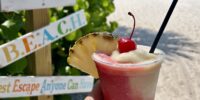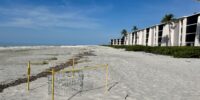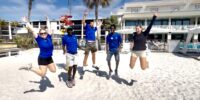Virtual Lesson from Sanibel Sea School
The entire Sanibel Sea School team does a great job of educating our guests and visitors and we wanted to share some of their lessons with you. Enjoy a virtual lesson, from Shannon of Sanibel Sea School, all about Lightning Whelks!
Lightning Whelks are a kind of sea snail known as a marine gastropod. They are called gastropods because they twist as they grow and the stomach ends up just above the foot, which they use to crawl around the sand. Gastro means stomach and pod means foot. These snails can get very big, especially the females, but they start out super tiny.
If you ever find a long, tan, spiral-shaped casing on the beach, it’s actually an egg casing from a Lightning Whelk. From each individual segment, a number of tiny snails will hatch. The strand can have up to 200 segments, each containing up to 99 snails. They start out not much bigger than a grain of rice and will continue to get bigger and bigger.
The snails begin to grow from the outer edge and continue to grow in a spiral, around and around as it gets bigger. The tip at the top of the shell is the oldest part and the first part formed.
In the Sanibel Sea School classroom at Sundial, there is a live Lightning Whelk in the observation tank. They have a beautiful dark purple body. The snail will pull itself into its shell to protect itself when Shannon picks it up. It does this for a few reasons. It may think it has encountered a predator and will seal off its opening, what’s called an aperture. The remaining part of the exposed snail is very tough and provides a seal, called the operculum. This allows them to lock in water and moisture and survive out of the water for quite a long time.
If you see the operculum present, you know the snail is still alive. Lightning Whelks are attached to their shells and remain a part of them for their entire life. If you find a shell that is empty, it is safe to collect. If you find one with a snail or other creature present, you need to place it back into the water to enjoy the rest of its day. If the snail dies, and the shell is empty, there is another creature that might move in: a hermit crab.
Hermit crabs will live inside of empty snail shells. They have two legs in the back that they will use to hook on and carry the shell around with them. They can switch shells as needed, for a better or bigger shell, but you should not remove them from their home. The use these found shells as their protection. Make sure to also check for hermit crabs when you are shelling. If someone is home, you need to leave the creature and its shell on the beach.
Sanibel Sea School at Sundial
“Our Sundial campus is located at Sundial Beach Resort & Spa, with access to Sanibel’s beautiful Middle Gulf Drive beaches just footsteps away. There are so many habitats to explore and creatures to discover nearby!
With a unique hands-on curriculum of half-day courses for kids where every day is a field trip, and customized sessions for private family groups, it’s an ideal place from which to explore the vibrant ecosystems of Sanibel Island. Find us poolside, next to the Slice of Paradice pizza shop.”






